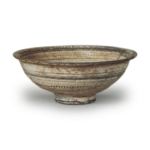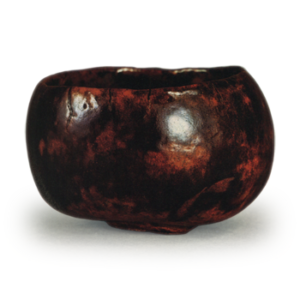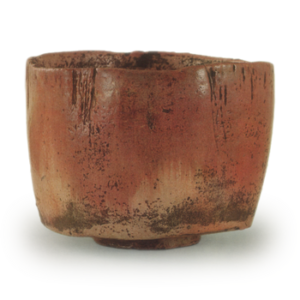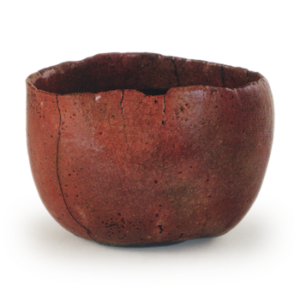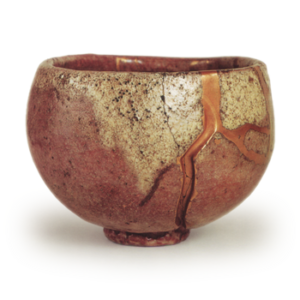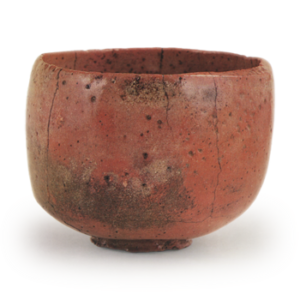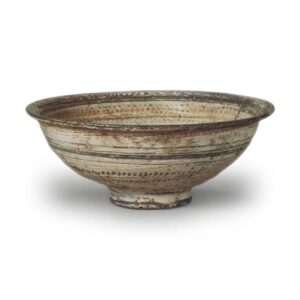
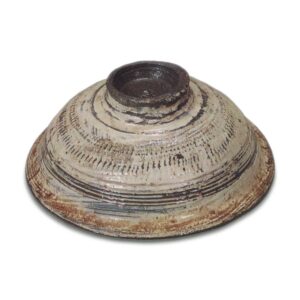
Collection: Nezu Museum
Height: 5.5cm
Diameter: 14.0cm
Outside diameter of foot ring: 4.5cm
Height of foot ring: 1.2cm
This is one of the most famous of the old Mishima tea bowls that have survived to the present day, and is known as Ueda Rekite by the name of its owner, and has been considered a famous tea bowl since ancient times. The name “Rekite” is another name for Mishima-te, and both names are derived from the fact that the pattern on the bowls resembles that of the Mishima calendar, and in some cases the bowls are referred to as Mishima Rekite.
In general, many of the Korean tea bowls that bear the name of their owner are from an earlier period, but Mishima also precedes other tea bowls in history, along with Ko-Unkaku and Ido. Or, in terms of the age of their appreciation, it is thought that they may be earlier than Ido, and may even date back to the early Muromachi period, due to their distinctive Mishima patterns and Reihin inscriptions.
The owner, Ueda, was a man whose name was known throughout the world, so he was probably a tea master of a certain status, but it is probably correct to assume that he was Ueda Sōka. Ueda Sōka was known as a military commander, but he was also famous as a tea master, and in particular, in this field, his name is well known as the owner of the Oribe Ikebana Iga Kogei. This is the Oribe Ikebana vase that Oribe gave to his pupil Ueda Sōka at his request, and it is known as the Oribe Ikebana vase because of the accompanying letter from Oribe to Sōka, in which he says that he feels as if he has given Sōka a fingernail. Even from this anecdote about the old Iga flower vase and Oribe, we can get a sense of Ueda Sokka’s character. In his later years, Sokka served as a retainer of the Asano family of Geishu, and he died in 1626 at the age of 88. It is thought that there are quite a few items in the Ko-Mishima collection that date back to the Muromachi period, but in the case of the Ueda Rekite, rather than being the first tea bowl to be made by Sōko, it is thought that his name was given to it because of its history, as he took it back from the area after going to war as a general in the Bunroku and Keichō campaigns.
As the tea ceremony was already at its height at the time of the Korean campaign, it is thought that the generals who went to war were all greatly interested in tea bowls, and the anecdotes of Katsudai and Gosomaru are also related to this. Mishima, which was discovered by Sōka, a passionate tea ceremony enthusiast who was so devoted to it that he even requested the old Iga ware that his teacher Oribe treasured, was indeed worthy of his eyes, and it is likely that it raised the fame of Ueda Roketsu in the world as a famous old Mishima bowl.
This is a particularly fine example of the characteristics of Mishima ware from Gyeryongsan (Chungcheongnam-do), and the brushwork is sharp and nimble. The Mishima pattern, which appears both inside and outside the bowl, is almost completely covered by the brushwork, and only appears here and there, giving the bowl a deeper flavor. There is a round design in the tea-drip well, and the sand-grain pattern surrounds this. The two lines that surround this further tighten the appearance of the well, and the exterior body lines are also well-defined. The foot ring is sharp and thin, and the shape of the bowl is further emphasized by the strong rim and side-grip. It is truly a rare and famous bowl that lives up to its name, and the true quality of Kosan-jima can be fully appreciated through this single bowl. There are two lines of gold lacquer decoration on the rim and body of the bowl.
Accessories include
Inner box: black lacquer with gold powder lettering “Kosan-jima Ueda”
Outer box: mulberry wood with gold powder lettering “Kosan-jima”
It is said to have been owned by Ueda Sokka, and was later in the possession of the Sakai family, who were the feudal lords of Himeji Castle, and was known as a famous item in the Sakai family’s collection. In modern times, it came into the possession of Nezu Aoyama, and is now in the collection of the Nezu Museum.

